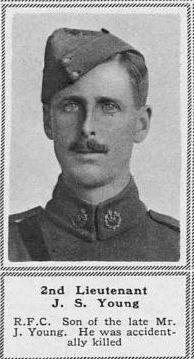John Stevenson Young
John Stevenson Young was born on 22nd August 1882 at Killermont House, Bearsden. This is still standing and is a part of Glasgow Golf Club (the golf course was laid out in the grounds of the house - heading for Maryhill Road coming from Canniesburn Toll, turn left at the traffic lights by Arnold Clark garage and then first right).
His father was also named John, a wealthy industrialist with interests in railways, running the coal and lime works at Baljaffray (near Windy Hill Golf Club?) and latterly a coal mine in the central belt. (Coal was mined at Baljaffray until 1910 and used for burning limestone - also found there - to make lime. However, the presence of significant pyrite deposits in the coal made it poor quality and unsuitable for further exploitation.)
His mother was Elizabeth (nee Marfarlan) and they lived in a villa called Crosslynn on Ralston Road.
It is not clear which modern house number this refers to but the name Crosslynn suggests a stream (Manse Burn, which runs alongside Drymen Road). Dunmyat, towards the bottom of the 1905 Valuation Roll above is now number 9 so counting back through the odd numbers suggests Crosslynn was/is 1 Ralston Road, on the north corner with Drymen Road.
John was the sixth of nine children - he was blessed with one brother and seven sisters.
When John was 13 his older brother, named James Glover Young, went ice-skating on St Germain's Loch, the ice broke and he was drowned aged 22.
Our next glimpse of John is in the 1901 Census when, aged 18, he was living at Crosslynn with occupation given as apprentice mining engineer.
(Just as a warning to anyone else researching John's life, another John Stevenson Young was born six month's after 'Bearsden John', in Cheshire, and also trained as a civil and mining engineer at almost the same time. 'Cheshire John' had the good fortune to survive the war and live a long life.)
We know 'Bearsden John' went to work in Mexico as an engineer and was working in South Africa in 1914 when the world war started. He returned home but there is no record of him immediately joining the armed forces. The coal industry was vital to Britain's industrial effort so he may well have been employed in the UK, although I can find no specific record of this.
On 4th April 1917 he joined the Royal Flying Corps at Farnborough:
He seems to have been based at Farnborough, Oxford and Winchester. His training must have been nearly complete by 3rd February 1918 because he was flying solo at Montrose Air Station on the east coast of Scotland (a major training base at the time, seen here in 1917):
His plane was a Sopwith Camel fighter:
The plane crashed and John was killed immediately. Contemporary newspaper reports say he was killed "while descending" which sounds as though he was trying to land the plane. However, a website specialising in causes of aircraft accidents reports: "Failed to come out of spin from at least 1500ft probably due to pilot losing consciousness." From the record of his death, he died from shock as a result of his injuries in a field adjacent to the aerodrome.










Comments
Post a Comment